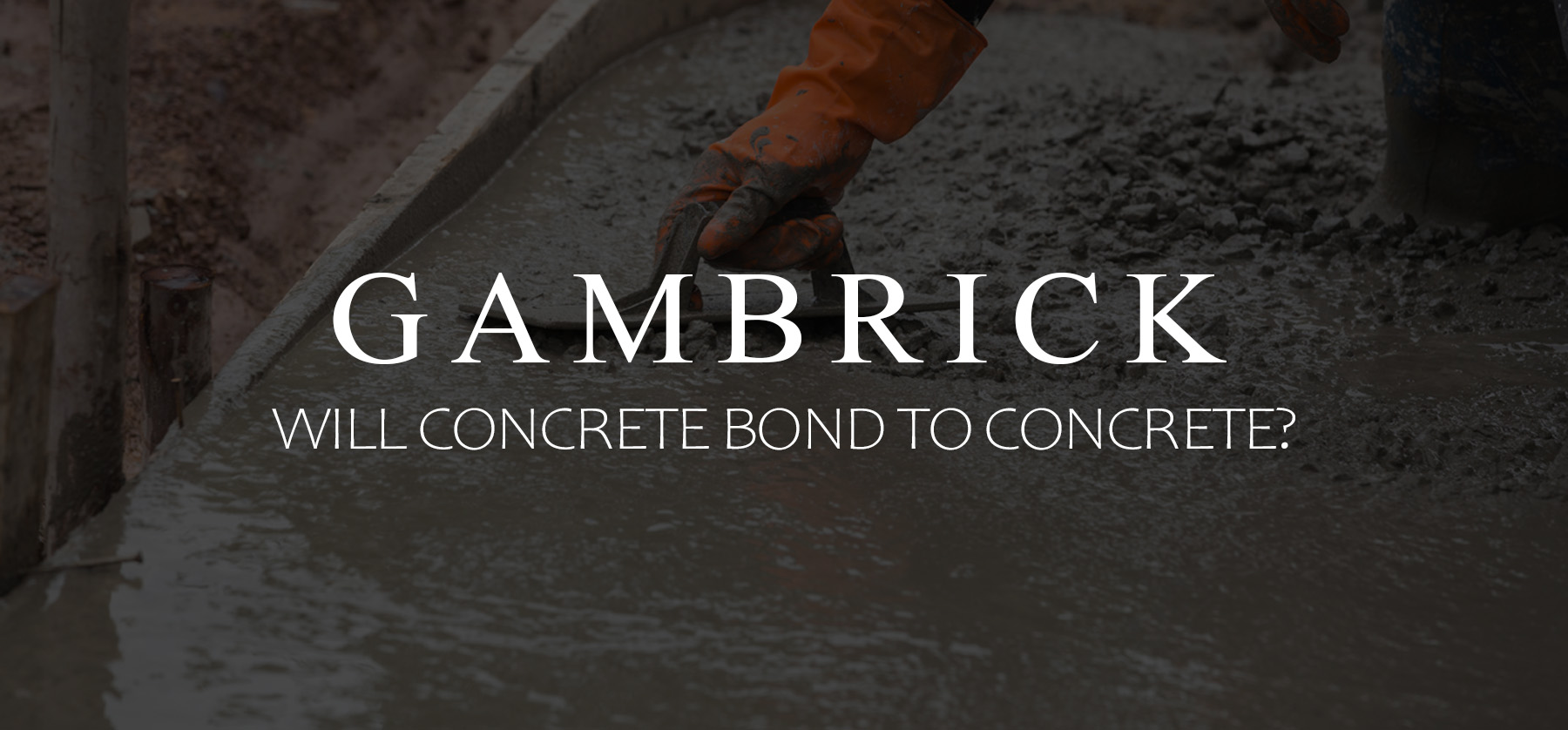
Will Concrete Bond To Concrete?
Concrete is a fantastic building material that’s known for it’s high compressive strength, but not it’s bonding ability. I’ve been a mason for over 25 years and can tell you firsthand that on its own, concrete will not bond to concrete or most other materials. You can pour concrete over old concrete, but it won’t stick. If you want to bond wet concrete to dry concrete, you’ll need a boding agent.
Concrete is made from sand, cement, gravel, and water. None of these ingredients are sticky, so concrete doesn’t bond well to other materials.
Mechanical reinforcement such as rebar and/or wire mesh can be used to attach concrete structures to each other. But to actually make concrete bond to concrete you need a chemical bonding agent.
Apply a chemical bonding agent to an existing concrete slab with a brush and/or roller. Once the agent dries, new wet concrete poured onto existing dry concrete will adhere.
Understanding how to make concrete bond to other materials is essential when you’re repairing old or pouring new concrete.
Eventually concrete will deteriorate. When it does, you either have to repair or replace it. Assuming the concrete is structurally sound, the least expensive choice is repairs. However, repair work means bonding concrete to concrete.
When you pour wet concrete on top of dry concrete, it’ll dry as an independent layer but won’t bond. Pouring 2 inches of new concrete on an existing 4 inch slab doesn’t create a 6 inch slab. By using a bonding agent, the two layers will adhere together. They’ll still be two separate layers, but stuck together tightly. It’s the same principle as gluing two pieces of wood together.
For this reason, you should always use a bonding agent when bonding wet concrete to dry concrete.
How Concrete Adhesion Works
Concrete is made by mixing cement, sand, stone and water. None of these ingredients has any natural bonding abilities. For this reason, when wet concrete is poured on top of dry concrete, it dries but does not actually bond. To bond wet concrete to dry concrete, you need to use a chemical binding agent first.
For concrete structures that are load bearing, such as beams and foundations, this issue is dealt with by using mechanical bonding. Steel is used to connect two or more concrete structures together, but they’re not actually bonded.
To bond dry concrete to dry concrete, you can use a bonding adhesive. These are basically very sticky thick glue.
- Adhesion between wet concrete and dry concrete is achieved by using a chemical bonding agent. Chemical bonding agents are used primarily for repairs or flat work where one concrete slab rests on top of another.
- Adhesion between dry concrete and dry concrete is achieved by used a bonding adhesive.
- Bonding two large scale concrete structures together requires mechanical steel reinforcement.
First, determine the purpose for bonding two slabs of concrete together. This will help determine the best way to do it.
- To pour 2 inches of new concrete over an existing 4 inch concrete slab, use a chemical bonding agent.
- If you’re attaching a concrete beam to a concrete pillar, use steel or bolts.
- To secure two pieces of a concrete statue together, use a bonding adhesive.
Concrete Bonding Agents
If you need to bond concrete together, you’ll have to use a bonding agent. Concrete simply won’t bond to concrete all on it’s own. A chemical bonding agent, bonding adhesive (glue), or mechanical bonding must be used.
- If you plan on making repairs to damaged concrete with new concrete, you’ll have to use a bonding agent. Simply applying fresh concrete to the old won’t make a strong repair. The new work won’t bond to the old and will eventually crack and chip away.
- The same problem arises when you need to pour a new concrete slab over an old one. Without a bonding agent, the two slabs won’t adhere. Water will work it’s way into the seam and possibly freeze. This will lead to heaving and cracks.
- What about if you have to stick two pieces of solid concrete together, such as when assembling a statue, you need a bonding adhesive. The pieces won’t stick together all on their own.
- Repair work is typically poured much thinner than the original slab, especially when repairing concrete floors. if a bonding agent isn’t used, the new thinner concrete will be very prone to cracking. Especially when water works it’s way into the seam. A tight bond helps prevent water penetration.
- Large scale concrete bonding is achieved with mechanical bonding agents such as rebar, steel or bolts. In these cases, adhesives are typically used to seal the seam.
Concrete repairs are generally cheaper than ripping out old concrete and pouring all new. But you have to do the repair work correctly in order for it to last. This means using bonding agents.
Why You Need To Use A Concrete Bonding Agent
Concrete is made of cement, stone and sand mixed with water. None of those ingredients contain any natural bonding agents. So when wet concrete is poured or applied to existing concrete, the two won’t join. Once cured, the new concrete will simply sit on top as a different layer. Since the new layer is typically thinner than the old, and lacking a strong bond, it’ll be prone to cracks.
You need to use a bonding agent to stick concrete to concrete. It’s that simple. Concrete won’t adhere to concrete all on it’s own. This produces weak repairs, structures and floors.
A bonding agent should be applied to the existing concrete to ensure the fresh concrete will adhere. This creates a much stronger structure or slab and helps prevent water penetration into the seam.
Remember, always prep the surface first. It must be very clean concrete and free of any dust or debris. I typically use a power washer and blower.
After prepping the surface, use a brush, roller or sprayer to apply the bonding agent. Follow the directions applicable to the type of agent you use.
Prepare The Surface For Concrete Bonding
No matter which bonding agent you use, or why you’re bonding concrete to concrete, the process should always begin with surface preparation. Chemical bonding agents and adhesives both need a clean surface to work their best.
- First, loose dirt, dust, rocks, sand, leaves etc. should all be removed. I usually do this with a blower, concrete brush or broom. This step removes anything loose that’s sitting on the concrete.
- Next, tough areas that contain mold, mildew or stains may require a pressure washer, cleansers or mechanical abrasion. This step cleans substances that have penetrated into the concrete’s pores.
Just sweeping the concrete’s surface of dust and dirt isn’t clean enough. That’s just a surface level cleaning. Make sure to clean inside the concrete’s pores, especially if you’ve got stains or grease.
Surface preparation is vital to ensure the bonding agent or adhesive works properly.
Choose A Bonding Method
There are two basic of bonding new concrete to existing concrete: Mechanically and chemically.
- Mechanical bonding: Examples of mechanical bonding are rebar, wire mesh or bolts. When you use mechanical bonding, the new concrete isn’t actually bonding with the existing concrete, it’s bonding with the mechanical means you used. When you use a mechanical bonding system, it’s very important that you build it strong. All the weight of the new concrete and the force needed to bond concrete to concrete, will be provided by the reinforcement.
- Chemical bonding: Chemical bonding actually sticks concrete to concrete. If you want to stick wet concrete to dry concrete, use a bonding agent. If you want to stick dry concrete to dry concrete, use a bonding adhesive.
The reason why you’re trying to bond concrete to concrete will dictate the best method for your project.
Liquid Bonding Agents
Liquid bonding agents are a great way to bond wet concrete to dry concrete. They’re perfect for repair work or for pouring a new slab over an existing driveway or patio.
- After the surface is properly cleaned, paint the bonding agent on with a brush, roller or sprayer.
- Allow it to dry until it feels tacky.
- Once the agent has become tacky, apply the new concrete.
Make sure you get bonding agent on every part of the existing concrete. If you miss a spot, new concrete won’t bond in that area.
The Best Concrete Bonding Agents
Rocland offers three bonding agents that are all very good. The choice depends on where the bonding agent will be used.
- Roc Latex is a synthetic resin liquid which needs to be mixed with water, sand and cement to make a slurry. This can be applied to an existing concrete surface to bond concrete to concrete. Apply the fresh concrete once the agent has become sticky. It can also be used before adding a resin surface, and for mortar and masonry joint repairs.
- Roc Prim is a two-part epoxy resin concrete adhesive which is mixed together on site. It’s used to bond two layers of dry concrete together and acts as a moisture barrier between the two layers.
- Placeo Cemcol is a very strong concrete bonding adhesive. It’s the best choice where the new concrete surface will contain hard aggregates, or be subject to heavy traffic. It’s supplied as a powder, which is mixed with water on site. The agent is applied to a concrete slab that’s been drenched with water the day before.
Each bonding agent should be thoroughly applied with a brush, roller or sprayer.
QUIKRETE Concrete Bonding Adhesive (No. 9902) permanently bonds new concrete, plaster, and stucco to existing concrete, plaster, and stucco. Eliminating the need for roughing the surface before application. Exceeds the performance requirements of ASTM C 1059 Type I and II.
Available in:
1 qt. bottle
1 gallon bottle
Use For:
- Bonding New Concrete to Old Concrete
- Bonding applications on concrete overlays 1″ or thicker
- Interior or exterior applications
What Will Concrete Stick To?
Concrete is not a sticky material and generally won’t adhere to things all on its own. But it will sometimes stick to wood and plastic but generally not metal.
Just because concrete sticks to something, doesn’t mean it’s bonded. Sticking and bonding are different things. Concrete can work it’s way into a materials pores and stick. But it’s not a strong bond that you can count on for long. A little force will usually free concrete from the material it’s sticking to.
For example, concrete can adhere to wood. Builders use wood forms to shape concrete, then remove the forms after the concrete cures. Sometimes the forms can get stuck to the concrete, but they’re not actually bonded together.
If you don’t want concrete to stick to wood or other materials, use a release agent. They make release easier. Oil based agents can be applied by the lumber yard or you can do it yourself. They work in the same way as spraying a frying pan before cooking.
Concrete can also stick to plastic. But again, it’s not a strong or reliable bond. This is a common issue when mixing small amounts of concrete in a bucket or mixing tray. But the concrete will come out with a little force.
If you don’t want concrete to stick, use a release agent. The most common types include:
- Oil-based: Linseed oil, mineral oil and paraffin all work well.
- Water-based: I like vegetable oils because they won’t discolor the concrete surface.
- Reactive: Fatty acids have a chemical reaction with the alkalinity in the concrete to prevent sticking.
What Will Concrete Not Stick To?
Most materials fall into the category of things concrete won’t stick to.
Concrete does not adhere to:
- Concrete: Concrete doesn’t have any natural bonding agents, so in order to get wet concrete to bond to dry concrete, a bonding agent must be used.
- Molds: Most concrete molds are made from urethane rubber which does not stick to concrete. These are used to make cast concrete products like statues and planters.
- Paint: Concrete won’t stick to a painted surface. When pouring fresh concrete over a painted patio, the paint should be removed first. However, some bonding agents and adhesives will stick concrete to paint.
- Oil: Surfaces with oil on them will not adhere to concrete. This is why most mold releases are oil based.
- Cement: Concrete is a cement based substance. Other cement based substances like grout and mortar typically won’t adhere to concrete.
To promote adhesion, use a chemical bonding agent. If you’re repairing damaged concrete, you’ll need the new concrete to bind to the old in order for the repair to last.
Downsides Of Bonding Concrete to Concrete
Although bonding concrete to concrete has some big benefits and makes some masonry repairs possible, there are downsides too.
Below are some of the cons that are worth considering:
- Maintenance: Pouring a new concrete slab over an old one can cause some new maintenance issues. When you pour concrete onto concrete, it creates a seam where the two slabs meet. Water can work it’s way into this seam, freeze and crack the new top layer. Typically the new layer is thinner than the bottom so it cracks easier. To prevent this, the new concrete should be sealed regularly and a bonding agent should definitely be used between slabs. This helps a lot with water penetration.
- Cracks: Concrete that’s bonded to other concrete, for example in repair work, is generally thinner than the first pour. This makes it weaker and more susceptible to cracks.
- Height: Adding new concrete over existing concrete increases the height of the slab. The thinnest you should even pour concrete is 2 inches, so this effects areas around doorways and stairs. It’s also an issue where walkways meet other flat surfaces like decks, patios, sidewalks, driveways, etc.
Will Cement Stick To Concrete?
No, on its own cement will not stick to concrete. Cement on it’s own does not contain any bonding agents. If you apply wet cement to dry concrete, the two will not bond. The cement will dry, and may stick for a little while, but will crack and/or flake off. This is because the two are not bonded.
To bond cement to concrete you need either a mechanical or chemical bonding agent.
- Wire mesh is the most popular example of a mechanical bonding agent that sticks cement to concrete. First, fasten the wire mesh to the concrete wall. Then, apply a scratch coat of cement. Once that dries you can apply you final coat of cement. The cement doesn’t actually bond with the concrete wall, but it’s secured to it by the wire mesh.
- Chemical binding agents can be used to stick cement to concrete. Apply the liquid agent to the concrete wall with a brush, roller or a sprayer. Once tacky, apply your cement. Because of the bonding agent, your fresh cement will now stick to the existing dry concrete.
This same principle is true of all cement based products like grout, mortar or concrete. If you want to stick a cement based product to concrete, always use a bonding agent first.
Remember, always apply chemical bonding agents to a clean concrete surface. This means not only sweeping but also power washing or scrubbing the concrete. You need to clean deep into the concrete’s pores and remove mold, mildew, dirt, grease, oil, etc.
Summary: Will Concrete Bond To Concrete?
Concrete is a fantastic building material that’s known for it’s high compressive strength, but not it’s bonding ability. On its own, concrete will not bond to concrete or any other materials. If you want to bond wet concrete to dry concrete, you’ll need a boding agent. Mechanical reinforcement such as rebar and/or wire mesh can be used to attach concrete structures to each other. But to actually make concrete bond to concrete you need a chemical bonding agent. Apply a chemical bonding agent to an existing concrete slab with a brush and/or roller. Once the agent dries, new wet concrete poured onto existing dry concrete will adhere.
Understanding how to make concrete bond to other materials is essential when you’re repairing old or pouring new concrete.
Eventually concrete will deteriorate. When it does, you either have to repair or replace it. Assuming the concrete is structurally sound, the least expensive choice is repairs. However, repair work means bonding concrete to concrete. Portland cement is not a bonding agent. It helps create strong concrete, but not bond. For this you need to use other means like a chemical bonding agent.
When you pour wet concrete on top of dry concrete, it’ll dry as an independent layer but won’t bond. Pouring 2 inches of new concrete on an existing 4 inch slab doesn’t create a 6 inch slab. What you get is 2 slabs sitting on top of each other. By using a bonding agent, the two layers will adhere together. They’ll still be two separate layers, but stuck together tightly. It’s the same principle as gluing two pieces of wood together.
If you have any questions or comments about bonding concrete to concrete, Email any time.

John Mazzuca | About | More Posts |
Custom Home Builder
John Mazzuca is a custom home designer and builder at Gambrick with over 25 years experience in the construction industry. John has designed, built and/or remodeled hundreds of homes, small buildings, and commercial projects. He writes about business, real estate, home building, and household electronics. His work has been featured in Fox Business, Better Homes & Garden, House Beautiful, and more.




















